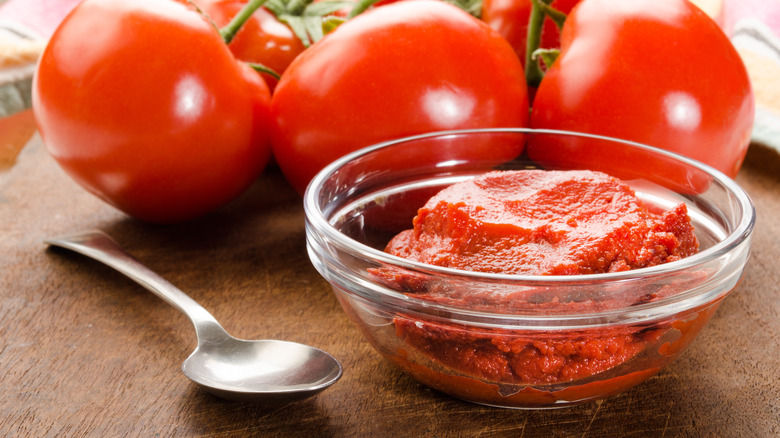The Timing Mistake You May Be Making With Tomato Paste
Tomato paste can lend an umami bomb of flavor to your recipe, but when it comes straight out of a can or tube, it often has a sharp, tinny taste to it. When you sit down to eat, you might feel like there's still echoes of that metallic twang in the dish. Maybe you're imagining it — but maybe you're not.
The thing about tomato paste is that it only helps your dish if you treat it properly. It needs to be cooked and cooked well to coax out the deep complexity we love about it. If you're not going to give it time to really cook, it's possible that your dish could have been better off without it. Let this be the last time you ever add tomato paste straight into liquid, be that broth or water. Instead, do what professional chef Joe Sevier does: Add it after your spices but before your liquids, and cook it until the color has changed from bright red to deep, brick red.
If you use tomato paste in your red pasta sauce, you'll want to give this tip a try next time you bust out the big sauce pot. We say it should take about two minutes to cook the paste, but follow the color cues and don't be tempted to finish too quickly. Depending on how hot your pan is, it could take a bit longer than this. If you're making a classic lasagna, for example, you're already committing to a relatively long haul cooking project. Make the time to cook the paste right and you won't regret it.
Why you should change how you cook tomato paste immediately
There are two main kinds of browning that happen when cooking food: The Maillard reaction, which browns protein, and caramelization, which browns sugars. In order to soften the mineral taste of tomato paste and let the savory glutamates shine through, the proteins need to brown and the sugars need to start caramelizing. This is what deepens the color from bright red to brick red when you're cooking tomato paste, and these processes happen at high temperatures. The Maillard reaction begins at 285 degrees Fahrenheit, while caramelization, depending on which sugars you're working with, ranges from 230 degrees to 397 degrees Fahrenheit. Since fructose and glucose are the main sugars in tomato paste, you're looking at 230 to 320 degrees.
The problem with adding tomato paste straight to a liquid or adding your liquid too soon is that, no matter how hard it tries, it's only going to get to approximately 212 degrees Fahrenheit. Why "approximately?" Because for every tablespoon of salt to quart of water, the boiling point raises 3-ish degrees. If you don't let your tomato paste get to between 285 and 320 degrees, you're not going to see those reactions happen.
Give it a try in these recipes
Have you ever made your own ketchup? To achieve an even deeper tomato flavor, take a moment to cook down the tomato paste before adding in the other ingredients listed. Not into ketchup? We can't blame you. It's not for everyone. But that doesn't mean you shouldn't keep everything we've talked about in mind when it comes to making sauces — try applying it to this homemade barbecue sauce instead, for example.
Do you use tomato paste in your chili or beef stew? If not, you should give it a try; the glutamates that produce the umami flavor complement beef so well. The famous Black Rose Irish pub in Boston adds it to their Guinness Beef Stew, and so should you. So, the next time you have a hankering to make a chili, pay some attention to how and when you add your tomato paste. It will make a world of difference, and for the amount of effort it takes, it's well worth it.


